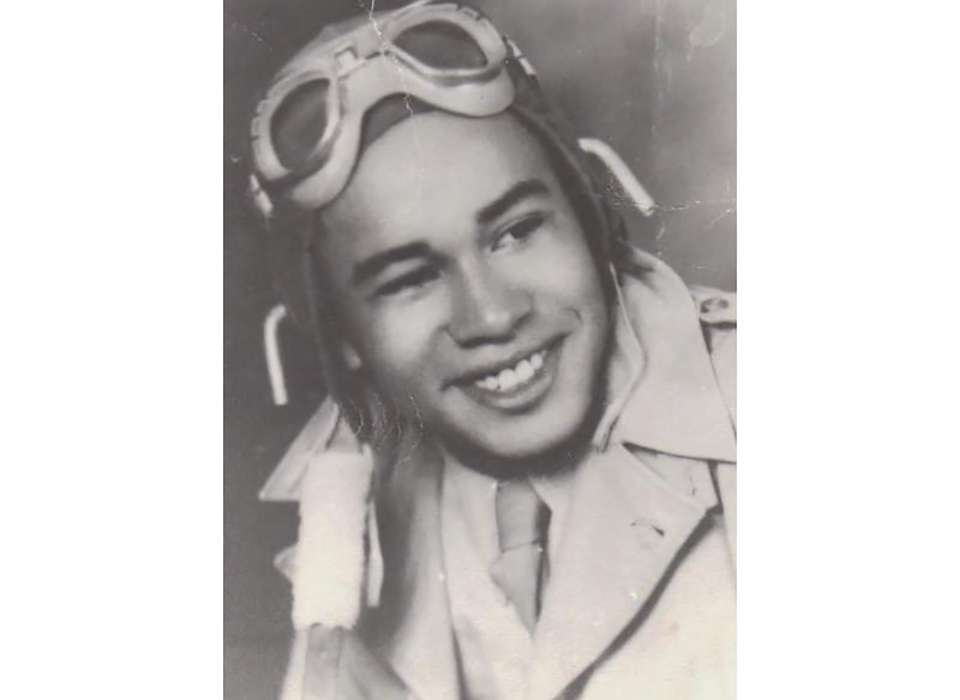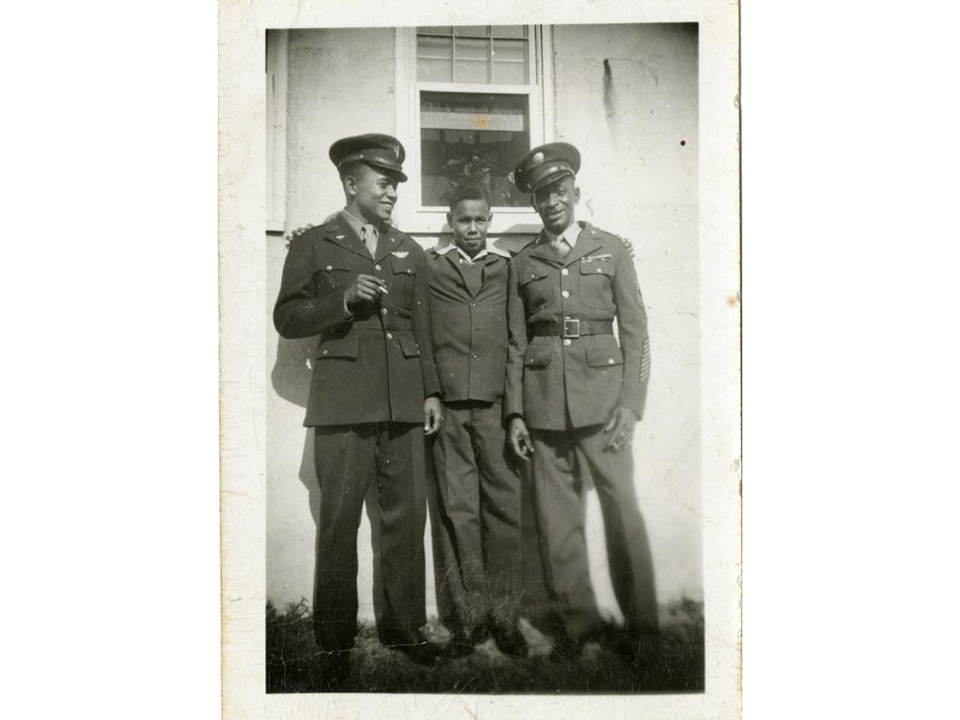Top Image: George Biggs during World War II courtesy of the Biggs family.
We have lost another of the Tuskegee Airmen. On September 19, 2020, George Biggs passed away in Tucson, Arizona, at the age of 95. He was the last living Arizona native who could be counted one of the famed Airmen.
Born George Washington Biggs in Nogales, Arizona, on July 2, 1925, he was the son of Dolores and Levi Biggs. He grew up in a family with a strong tradition of military service. George’s father, Levi, was a proud member of the 25th Infantry Buffalo Soldiers. In 1918, during World War I, he spent time at Camp Little in Nogales. Levi Biggs remained in the Army for 26 years, and eventually rose to the rank of a Master Sergeant. He and Dolores had five children. George was the oldest.
According to his daughter, Rose Biggs-Dickerson, even before Pearl Harbor, George Biggs attempted to follow in his father’s footsteps and enter the military. He was turned away, though, because of his age. His father wanted him to finish high school before thinking about the Army. Documents show that while he waited to turn 18, he did laundry at Fort Huachuca, in Arizona, where his father was stationed.
Finally, Biggs registered for the draft on July 3, 1943, the day after his 18th birthday. To contribute to the American war effort, he did not want to be assigned to jobs like being a cook, which were one of the few options available for African Americans who wanted to serve. Three months later, he enlisted in the Army. Once he made it through Basic Training, he qualified for Aviation Cadet Training at the recently activated Keesler Field in Biloxi, Mississippi. From there, as one of those who trained at Tuskegee Army Air Field in Alabama for combat in Europe, Biggs became part of history. What is remarkable is that when George joined the military, he did not yet know how to drive a car, much less have any experience with aircraft!
George Biggs did not take the path of those legendary Airmen of the 332nd Fighter Group who flew the “Red Tails.” No, he trained to be part of a bomber crew, like the often overlooked black airmen in the 477th Bombardment Group. He underwent a program in aerial gunnery at Tyndall Army Airfield, near Panama City, Florida. At Godman Army Airfield at Fort Knox, Kentucky, he was selected for navigator/bombardier training in September 1944. This would prepare him for missions in Europe on the B-25 Mitchell. In April 1945, shortly before Nazi Germany capitulated, Biggs completed navigator training. Two months later he became a Master Sergeant in the US Army Air Forces. Then, he moved to the final hurdle: bombardier training. When that was finished in October 1945, the war had been over a month. Missing combat really frustrated Biggs. In a 2009 interview with Nogales International, he told the reporter what he and the other trainees felt that October. “We were really pissed off that the war ended before we could see what we could do.”
Biggs Family Photo Taken Circa 1943. George Biggs (left) with his brother, John Biggs (middle), and Levi Biggs, Sr. (right). Unknown, “Biggs family photo,” Special Collections Online Exhibits, accessed September 29, 2020, http://speccoll.library.arizona.edu/online-exhibits/items/show/2049
Discharged in 1946, Biggs did not find happiness with civilian employment opportunities. So he decided to re-enlist, as a non-commissioned officer, in the newly created United States Air Force. Subsequently, he got his chance to experience combat. During the Korean War, as a Second Lieutenant, he flew missions on B-29 Superfortresses from Okinawa and B-26 Marauders from South Korea.
Following the 1953 cease-fire on the Korean Peninsula, Biggs returned to the States. At Little Rock Air Force Base, he sharpened his skills on B-47 Stratojets. Later, he was stationed at Davis-Monthan Air Force Base near Tucson, Arizona. Rose Biggs-Dickerson, noted that he was one of the first African American officers stationed there. While at Davis-Monthan, he worked hard to help other black airmen settle into life at the base.
Biggs never downplayed the discrimination he and other black service members faced. It was real, disgraceful, and prolonged. He recalled how pilots at first did not trust his skills as a navigator. Accounts from World War II of how Axis prisoners of war were often treated better than African American soldiers, sailors, airmen, and Marines deeply affected him. He never let racism suffocate his spirit, however. Biggs rose to the rank of major.
After the beginning of the Vietnam War, Biggs had a final opportunity for combat. He flew missions on the B-52 during the conflict. In July 1970, with more than two decades in the military behind him, he retired from the Air Force. There were different challenges for him at home. Biggs had to raise his children alone after his wife tragically perished in an accident.
After his retirement, Biggs built a new life for himself. He remarried, wedding Olga Rascon, another Nogales native. Olga brought three children to the household. In 1974, he became an agent for the United States Customs Service.
George Biggs’s second retirement started in 1994, when he left the Customs Service. But he hardly slowed down. Just as he once embraced service to the nation during World War II, Biggs now embraced service to the community. As commander of his local Veterans of Foreign Wars, he planted flags at the graves of veterans buried in Nogales City Cemetery every year on Memorial Day. The visit to Levi Biggs’s grave was special and somber. George stood at attention and saluted his father. One could also expect to see him in the annual Veterans’ Day parade. As a member of the Knights of Pythias, Biggs enthusiastically participated in the yearly tradition of putting on a Christmas Day dinner for foster children. People in Nogales, Arizona knew who he was.
Biggs lived to see public recognition for the accomplishments of the Tuskegee Airmen. Receiving the Congressional Gold Medal in 2007 and getting a salute from President George W. Bush meant so much to him. Six years later, Arizona Governor Jan Brewer signed a law establishing the fourth Thursday in March as a day of commemoration for the Airmen.
Rose Biggs-Dickinson emphasizes, though, that her humble father always rejected the term “hero.” Invited to speak in 2016 by the Cochise College Fine Arts Department, Biggs declared, “It’s true, all I did was what I was supposed to do.”
For his 95th birthday in July 2020, Arizona’s Congressional Representative Ruben Gallego said of George Biggs, “I believe that Mr. Biggs’s character and actions truly embody what it means to serve one’s country.” “Not only did he fly in multiple wars,” Representative Gallego stated, “he rose above expectation and obligation as a Navigator and an officer. In addition to his time in the Army Air Corps and Air Force, his integrity, modesty, and principled character are values that we can all learn from and should strive to emulate.” On news of his death, former Governor Brewer and Senator Kyrsten Sinema lauded his years of service.
Indeed, George Washington Biggs devoted most of his adult life to causes greater than himself. He left behind much good will and respect. Biggs is survived by his wife, Olga, 10 children, 22 grandchildren, and 24 great-grandchildren.
Jason Dawsey, PhD
Jason Dawsey, PhD, is ASU WWII Studies Consultant in the Jenny Craig Institute for the Study of War and Democracy.


